#alexander delacroix
Text
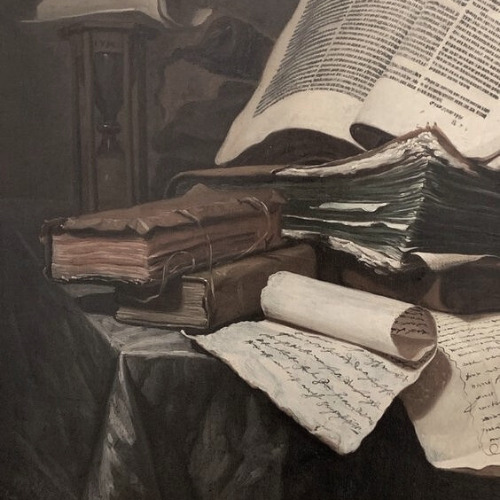








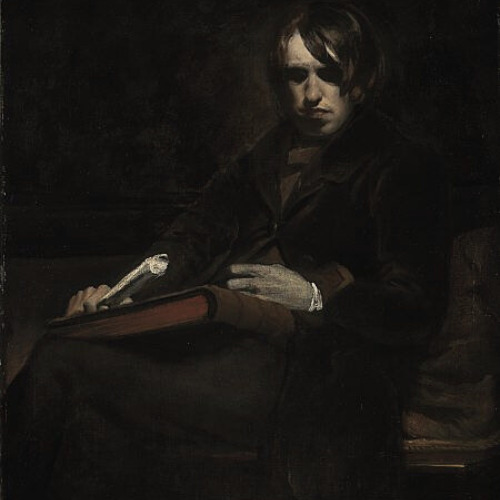





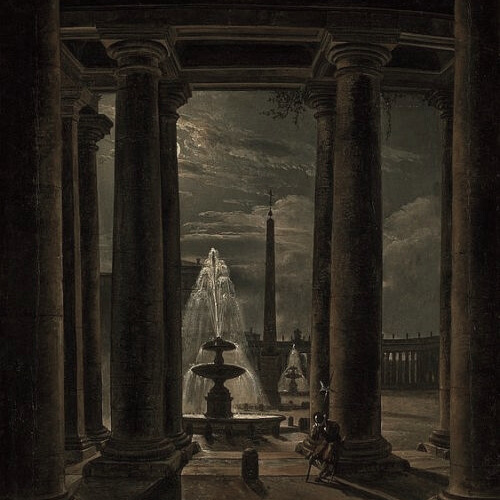

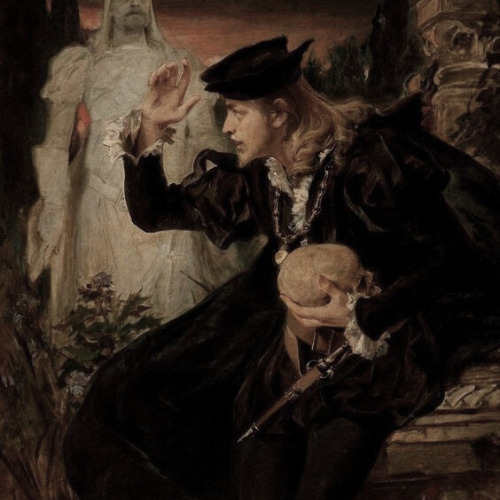
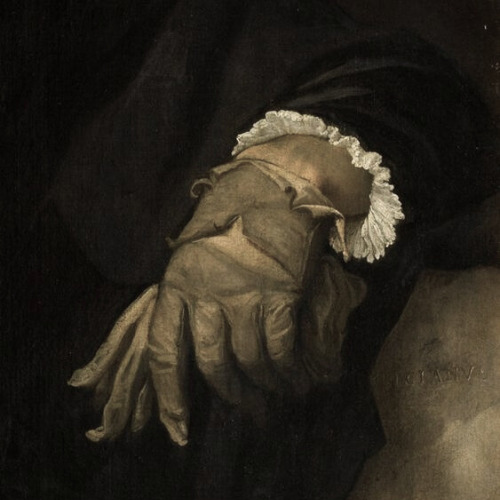

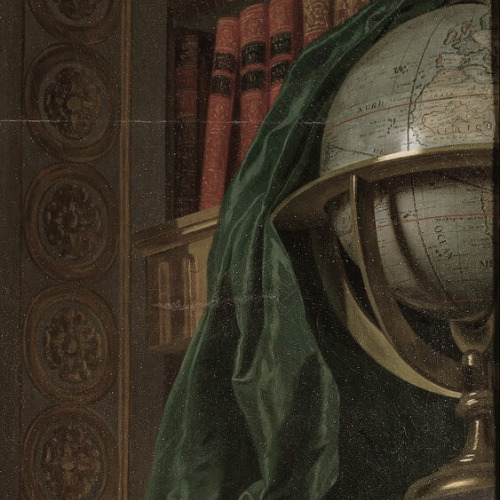



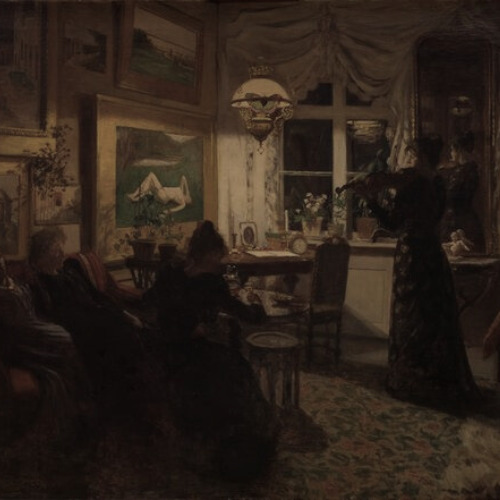



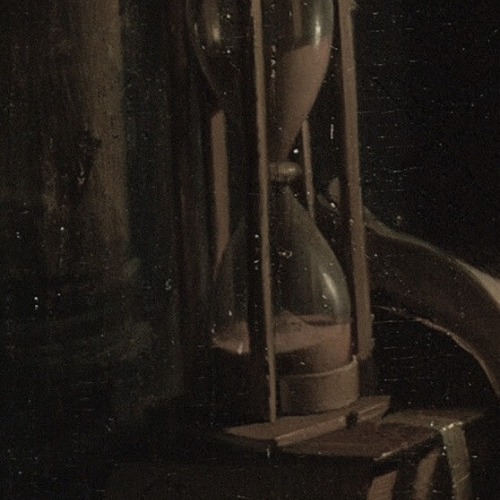

art aesthetics: dark acadmia
#cant find artist#artist is gerrit dou#artist is paul fischer#artist is james carroll beckwith#artist is sir anthony van dyck#artist is nicolas regnier#artist is hubert and jan van eyck#artist is eugene delacroix#artist is jan willem pieneman#artist is sir william fettes douglas#artist is wilhelm bendz#artist is carl holsoe#artist is jacopo tintoretto#artist is thomas wyck#artist is lindsay bernard hall#artist is franz ludwig catel#artist is pieter claesz#artist is pedro americo#artist is titian#artist is giorgio vasari#artist is alexander roslin#artist is jusepe de ribera#artist is anne francoise couloumy#-artist is carl holsoe#artist is anna petersen#artist is peter hasenclever#artist is irving ramsey wiles#artist is georges de la tour#artist is unknown-#art aesthetics
373 notes
·
View notes
Text
The Many Faces of Ophelia
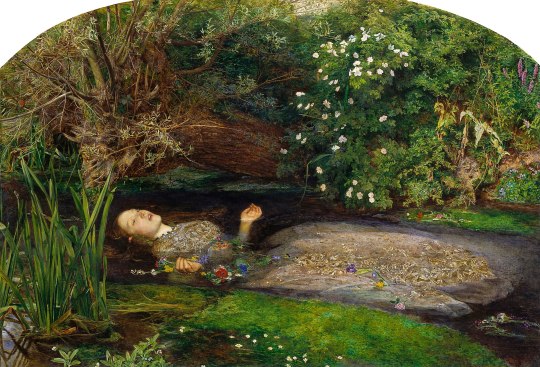
John Everett Millais • Ophelia • 1851–52 • Tate Britain, London
Millais's painting depicts Ophelia, a character from William Shakespeare's play Hamlet, singing before she drowns in a river.

Pierre Auguste Cot ( French, 1837-1883) • Ophelia (Pause for Thought) • 1870 • Private collection
Another haunting version of Ophelia belongs to the French portraitist Pierre Auguste Cot, well-known for his portraits and romantic scenes. The painting is not a direct illustration of Hamlet, but rather a glimpse into the dark and terrifying mind of Ophelia after Hamlet refused to marry her and then killed her father Polonius. What might seem to be an innocent look of a young maiden, looks downright creepy and unsettling, hinting at Ophelia’s soon-to-come decision to take her own life out of grief and madness.
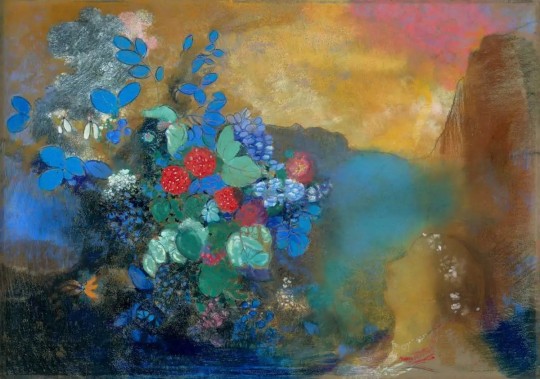
Odilon Redon (French, 1840-1916) • Ophelia Among the Flowers • c. 1905-08 • National Gallery, London
Redon’s version of the story is in no way an illustration of the original text written by Shakespeare, but rather a dreamlike impression of it.
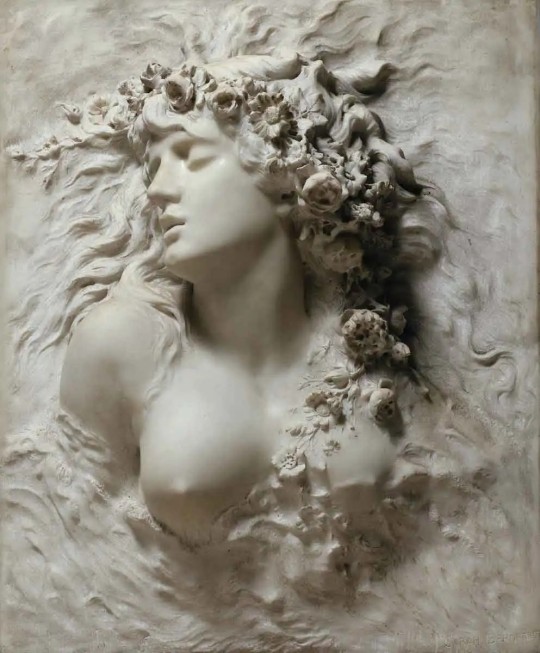
Ophelia • Sarah Bernhardt • 1880
Sarah Bernhardt's version, perhaps too idealized to be a direct reference to Shakespeare’s text but nevertheless has one important feature. If we look at the photographs of Bernhardt, we can recognize her own facial features in her depiction of Ophelia. In fact, Bernhardt did play Ophelia on stage in 1886, only six years after making the piece. During the production, she insisted on developing her role further. Instead of the death of Ophelia being indicated by a closed coffin carried out to the stage, Bernhardt was brought to the public, playing a lifeless body herself.

Paul Albert Steck ( 1866-1924) • Ophelia • 1895 • Musées de Paris
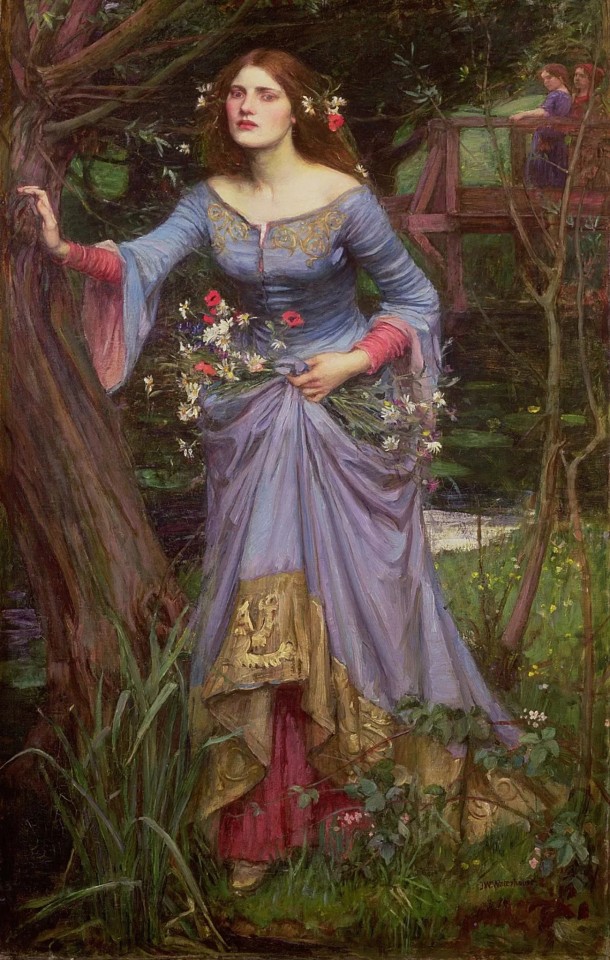
John William Waterhouse (British) • Ophelia • 1910 • Private collection
"Her clothes, stretched out, carrying her like a nymph; which time she chanted snatches of songs he sang as if knew not troubles or was born in the element of water; so to last could not, and apparel, hard upivshis, unhappy from the sounds of dragged into the quagmire of death." ~William Shakespeare, Hamlet

Paul Delaroche (French, 1797-1856) • La Jeune Martyre (The Young Martyr/Ophelia) • 1855 • Musée du Louvre, Paris

Alexandre Cabanel (1823–1889) • Ophelia • 1883 • Private collection.
Source: Wikimedia Commons.
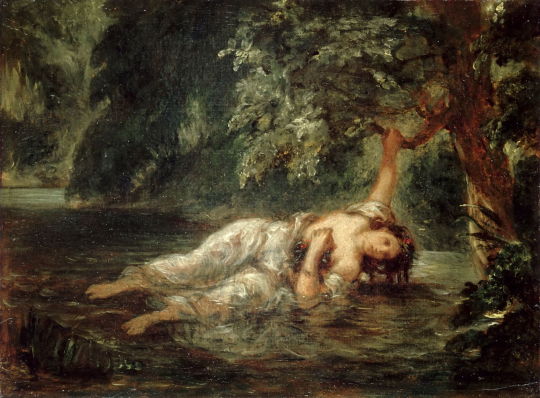
Eugène Delacroix (1798–1863), The Death of Ophelia (1853) • Musée du Louvre, Paris.

Theodor van der Beek (German, 1838-1921) • Ophelia • 1901 • Private collection
#ophelia#william shakespere#art#painting#fine art#art history#literary painting#hamlet#german artist#french artist#eugène delacroix#theodore van der beek#alexander cabanel#john william waterhouse#paul delaroche#paul steck#pierre auguste cot#british artist#odilon redon#sarah bernhardt#sculpture#oil on canvas#john everett millais
61 notes
·
View notes
Text
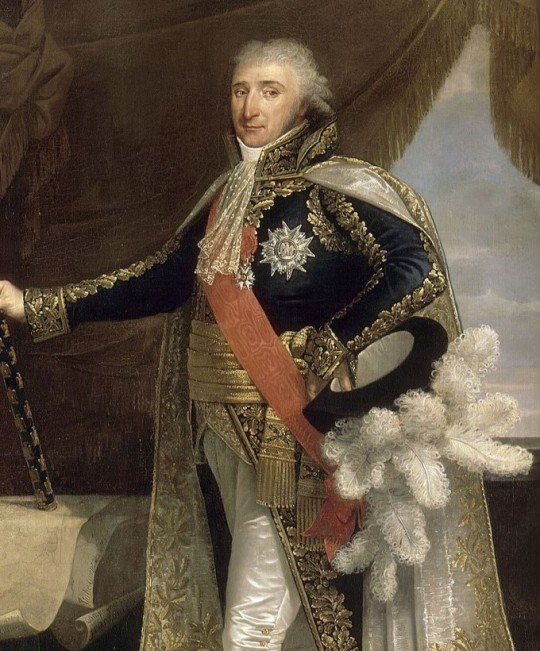


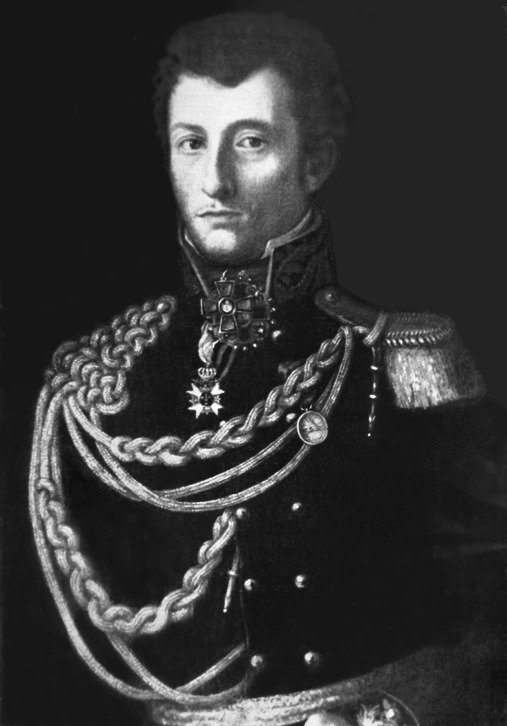

*aka "who are you most shocked/surprised/upset/aghast that we lost in the first round?"
Propaganda for Each:
Augereau:
“dude’s backstory is a fucking dungeons and dragons adventurer backstory, duellist who had to flee France after killing an officer, adventurered in Prussia and Russia and duelled and fought, also cannot physically stop swearing, what a man”
“Man of many talents even before the Revolution: noted swordsman and duellist, so talented that he accidentally killed a superior officer. Joined armies all over Europe, then taught fencing and dancing after he settled. Eloped with his first wife, whom he loved and respected. Partly responsible for victories at Castiglione and Arcole during the Italian campaign. Tied himself to a horse to lead his corps on Eylau (very metal). Has a very cool portrait where he points at a portrait of himself at Arcole
Gogol:
[no propaganda submitted]
Gros:
One of Napoleon’s main painters. Pioneer of French Romanticism. Inspired many artists such as Delacroix and Géricault. He was very pretty.”
Clausewitz:
"what could possibly be sexier than a prussian uniform and a lasting impact on military theory?”
Czartoryski:
"Decided that the way to free Poland was by having a threesome with Alexander and his wife.”
#napoleonic sexyman tournament#naps ironically lost by more than a percent#although coming back to win a redemption poll was so on brand for him that I almost tweaked the rules for it
45 notes
·
View notes
Text
Desert Sands
read it on AO3 at https://ift.tt/aQPgnYf
by BrattyPaganSub
Sam drags Bucky to Vegas for a vacation
Words: 773, Chapters: 1/1, Language: English
Series: Part 4 of Days in Delacroix
Fandoms: The Falcon and the Winter Soldier (TV), Marvel Cinematic Universe
Rating: Explicit
Warnings: Creator Chose Not To Use Archive Warnings
Categories: M/M
Characters: Sam Wilson (Marvel), Alexander Pierce, James "Bucky" Barnes, Steve Rogers
Relationships: James "Bucky" Barnes/Steve Rogers, James "Bucky" Barnes/Sam Wilson
Additional Tags: Past Stucky, Anxious Bucky Barnes, Bucky Barnes Needs a Hug, Bucky Barnes Recovering, Bucky Barnes Has a Large Penis, Sam Wilson has a large dick, Ass Play, Anal Fingering, Blow Jobs, Hand Jobs, Spanking, horny jail, Horny Sam Wilson, Las Vegas, Post-Traumatic Stress Disorder - PTSD, Bucky Barnes Has Issues, Bucky Barnes Remembers, Bucky Barnes Has Panic Attacks, Sam Wilson is a Gift, Sam Wilson Loves Bucky Barnes, Bucky Barnes Loves Sam Wilson, Why Did I Write This?, One Shot, Porn With Plot, Porn with Feelings, Bottom Bucky Barnes, Top Sam Wilson, Couch Sex
read it on AO3 at https://ift.tt/aQPgnYf
#Bucky#Captain America#Winter Soldier#Sam Wilson#James Barnes#Falcon#SamBucky#BuckySam#IFTTT#ao3feed
3 notes
·
View notes
Text
Napoleon and theatre.
Not until Napoleon emerged as First Consul, already with a firm hand on power, could the players rely on political support rather than carping censorship. In 1803, a bill re-created the troupe and reasserted its rights as the Théâtre Français. Napoleon Bonaparte had a profound personal engrossment in theatre. He had plays, and in particular classical tragedy, read in private and played on stage at Saint-Cloud, as a principal entertainment, but also for use as a tool for power. Even his weekly attendance at the theatre was also to make his presence felt and gauge reactions to his arrival. He intervened personally in both the choice of repertoire and the actors's interpretation. He had already advised Talma on how he was expected to play the part of the Emperor Néron in Britannicus.
The five years from 1808 were meanwhile punctuated with summons to Napoleon's displays of imperial power. The 1808 Congress of Erfurt was brought together to cement the agreements of the 1807 Treaties of Tilsit, between Emperors Alexander and Napoleon, and then Napoleon with Prussia. Alexander was to be flattered, the German kings and princes put firmly in their place. The entertainment was lavish; for the evenings, the Comédie-Française brought its leading actors and highest theatre: no fewer than sixteen tragedies, mostly Racine, Corneille, and some Voltaire: Mithridate, Andromaque, Britannicus, Phèdre, with Talma instructed by Napoleon to emphasise lines which could be interpreted to please Alexander; Iphigénie en Aulide and Bajazet featured too, but not Athalie, with its dynastic figure of Joas a possible reminder of the Bourbons in exile. The élite of Europe were there dutifully to receive Napoleon's choices. Talma was praised, Napoleon and Alexander were able to continue their expansion schemes.
John Sayer- Jean Racine, Echoes across Europe

Talma as Nero in Racine's Britannicus, by Eugène Delacroix
#napoleonic#john sayer#jean racine- echoes across europe#napoléon bonaparte#françois joseph talma#alexander i of russia#history of theater
41 notes
·
View notes
Photo
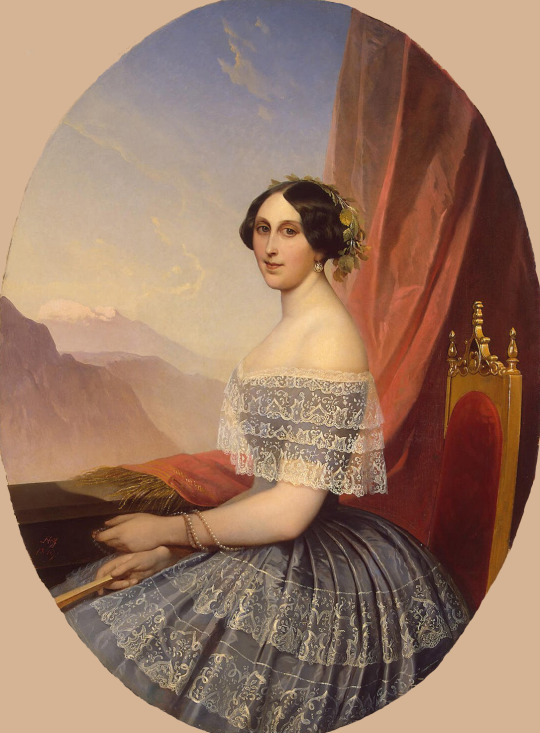

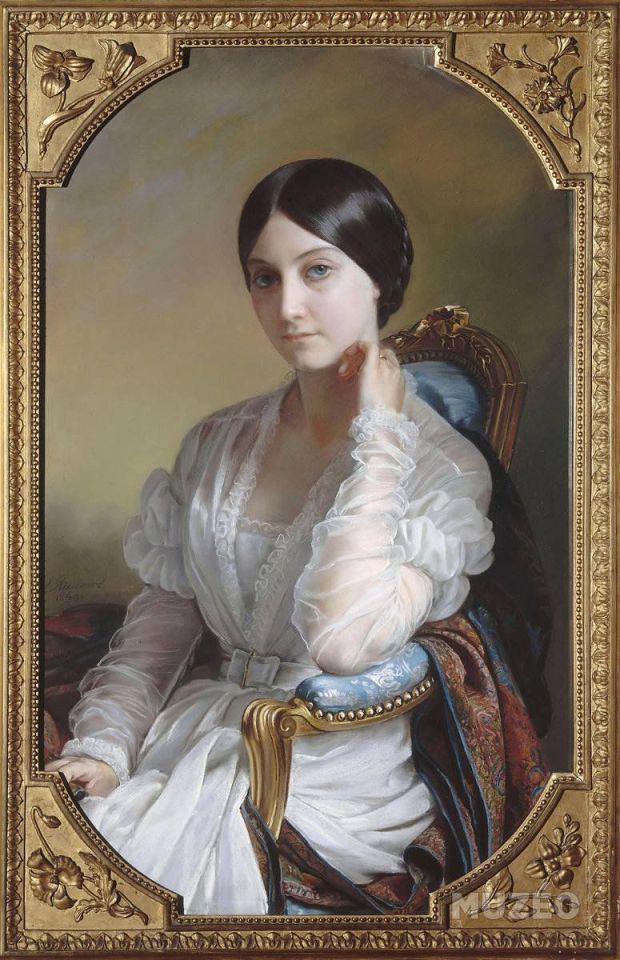

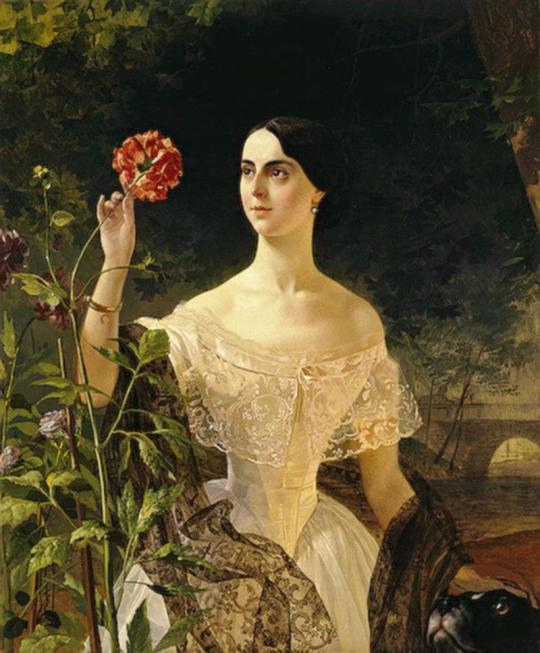





Closing the 1840s -
Top: 1849 Grand Duchess Maria Mikhailovna (?) by Carl Timoleon von Neff (Hermitage) 1085X1473 @72 492kj. The Hermitage lists this as "Portrait of a Young Woman." However Dru identified the sitter as Grand Princess Maria Mikhailovna in a posting to the Alexander Palace Time Machine Discussion Forum of 27 September 2011 and another poster agreed with some doubt.
This work appeared to be unfinished, the background was not over-painted in an oval all around, although a guideline was made and much of the oval was completed. I filled in the unfinished background with Photoshop.
Second row left: 1849 Elizabeth A. Poletika (1832-1854), daughter of Idalia Poletika, in marriage Mordvinova by Vladimir Ivanovich Hau (location ?). From Wikimedia 1536X1973 @200 434kj.
Second row right: 1849 Madame Leon Reisener by Henri-François Riesener (Musée national Eugène-Delacroix - Paris, France). From pinterest.com/CardRichelieu/portrait/ 775X1200 @72 254kj.
Third row: 1849 Comtesse Charles d'Agoult, née Marie de Flavigny, and Her Daughter Claire d'Agoult by Jean Auguste Dominique Ingres (Morgan Library & Museum - New York City, New York, USA). Old image from unrecorded source 2214X2677 @300 2.4Mj.
Fourth row left: 1849 Countess Sofia Andreievna Bobrinskaia, née Shuvalov by Karl Brullov (Hermitage). From liveinternet.ru/users/4000579/post386885193 800X968 @72 224kj.
Fourth row right: 1849 Delfina Potocka by Paul Delaroche (location unknown to gogm) photo - Maciej Szczepańczyk (Mathiasrex). From Wikimedia 1143X1418 @72 2.9Mp.
Fifth row: 1849 Harriet Sutherland-Leveson-Gower, Duchess of Sutherland by Franz Xaver Winterhalter (Dunrobin Castle, Sutherland, UK)> From Wikimedia; removed spots & flaws & fixed edges w Pshop 1086X1700 @300 409kj. She was a Lady-in-Waiting to and close friend of Queen Victoria. Dunrobin Castle is the family seat of the Sutherland family,
Sixth row left: 1849 Dowager Queen Adelaide by Richard James Lane after Franz Xaver Winterhalter (British Mueum). From their Web site 1737X2500 @300 1.8Mj.
Sixth row right: 1849 Erzherzogin Sophie von Österreich, Prinzessin von Bayern by Josef Kreihuber (auctioned by Neumesiter). From their Web site 2407X3307 @300 2.1Mj.
Bottom: 1849 Comtesse de Bellefonds by Jean-Hégésippe Vettier (Musée des Beaux-Arts de Bordeaux - Bordeaux, Aquitaine, France). From collections-musees.bordeaux.fr/ow4/mba/images/006-074-1559; fixed spots. bottom edge, & cracks w Pshop 820X1024 @72 246k.
#1849 fashion#Romantic era fashion#Maria Mikhailovna#Carl Timoleon von Neff#early Victorian fashion#straight coiffure#off shoulder neckline#lace bertha#floral headdress#Elizabeth A. Poletika#Vladimir Ivanovich Hau#V waistline#full skirt#Madame Leon Reisener#Henri-François Riesener#jacket#long sleeves#Marie de Flavigny#Claire d'Agoult#Jean Auguste Dominique Ingres#high neckline#collar#Countess Sofia Andreievna Bobrinskaia#Karl Bryullov#Delfina Potocka#Paul Delaroche#Harriet Sutherland-Leveson-Gower#Duchess of Sutherland#Franz Xaver Winterhalter#wrap
12 notes
·
View notes
Text
Umbrella Pharmaceuticals - Chapter 8
Querido padre:
Te envío una carta adjunta a un memorándum que no es convencional. Temo que lo que leas en él no sea de tu agrado, pero tomé la decisión de arriesgarme y de utilizar este papel para explicarte mi idea. Porque es una idea que, por una parte, me consterna y, aún por increíble que suene, deseo tu comprensión.
Vi una película llamada Metrópolis, del director Fritz Lang. Es una cinta futurista alemana cuyo final te habría gustado. Lo relevante sobre esta obra es que hay un personaje llamado Maria que actúa como una especie de Marianne de Delacroix. Esta Maria es reemplazada por una autómata que se apropia de su liderazgo. El papel desempeñado por ambas Marias es opuesto; la Maria original reconcilia las fuerzas proletarias y burguesas, mientras que la Maria autómata engaña a las fuerzas proletarias para que destruyan la ciudad. Fue la Maria autómata la que me inspiró para desarrollar la idea que en el memorándum te detallo.
La idea consiste en emplear mis conocimientos en genética para crearte a ti, padre, un continuador de tu legado. Tú siempre me quisiste, me diste todo el amor que un padre puede ofrecer a su hijo; y nunca supe como corresponderte. Y eso me entristece. Me avergüenza detallar que escribo esta carta con lágrimas en los ojos porque tú siempre intentaste ser el mejor padre; mientras que yo albergo dudas sobre si he sido el mejor hijo. A lo mejor es consecuencia de mi decaído estado de ánimo, pero esto es todo lo que siento. Quiero hacer algo por ti; algo que pueda corresponderte de la mejor forma posible porque no quiero que mi inexperiencia te obstaculice.
Te quiero, padre.
El título provisional del proyecto es Código: Veronica.
Mi idea consiste en la creación de un embrión cognitivamente dotado para garantizar su futura competencia científica. El principal modelo que utilizaré para la creación de este embrión será Veronica Ashford. Ella fue una persona cognitivamente dotada que gozó de buena salud y que además destacó por su apariencia física y perspicacia. Con ella como modelo, mi tasa de éxito es de en torno a un 50%. Como la exacta replicación de un ser humano es imposible, emplearé distintos métodos de la ingeniería genética con los que estoy familiarizado para, en primer lugar, secuenciar el genoma completo o parcialmente completo de Veronica Ashford a partir de sus restos; y en segundo lugar, seleccionar una serie de óvulos viables y modificar su ADN según el genoma de Veronica Ashford. El último paso sería la fecundación y esperar a que alguno de ellos sea exitoso. Si es un éxito, lo que nacería sería como una reencarnación de Veronica Ashford; una Maria autómata manufacturada a imagen y semejanza de la original.
Un trabajo preciso que no admite errores, pero por el que estoy dispuesto a sacrificarme si así lo consideras.
PD: No pienso contarle nada a mamá y a ningún otro Stuart hasta que tú lo decidas.
Atentamente,
Alexander Ashford
2 notes
·
View notes
Text

Name: Amelie Victoria Delacroix
Age: 21
Race: Half-elf
Amelie is a slim young woman that stands at about 5′5″. She is the spitting image of Arata with the same dark fluffy black hair and dark brown eyes. Often seen with a serious expression on her face, this caused others to compare Amelie’s looks to that of a doll when she was younger, a comparison she is not quite sure whether she cares for or not. Amelie herself displayed a maturity beyond her years and a sense of seriousness even as a young child. The exact opposite of rambunctious, she would rather plan out the pros and cons of an action first rather than rush headlong into it. This often led to many calling her an odd child, and some not quite “getting” her, but that as well never bothered her. She had her mother, father, Yuka, Esme, Callie, and those that surrounded them, why would she care what unimportant people thought?
Despite how she may come across as apathetic to some, Amelie actually has a tendency to devote herself 100% to something when she cares about it, that being a person, skill, or more. Sometimes, this leads to her being almost too ambitious and focusing solely on what she wants to achieve, losing sight of everything else and sometimes not realizing when she’s crossing a line. She is also fiercely protective of those she loves. Still, Amelie has a caring side and enjoys spending time with her family and friends despite it all.
Amelie is the daughter of Arata and Olivier Delacroix, born from the relationship they both had when they were younger. Olivier discovered her pregnancy after their relationship ended and decided to keep it hidden for as long as she could until she could figure out the best way to break the news to her uncle, who had been unaware of their relationship, and Arata himself. However, before she could, Olivier’s uncle, and seemingly Arata, were killed in a meeting gone wrong with Alexander Moore. The resulting fallout left Olivier on the run and in hiding as the rest of her faction was destroyed by the Moore family, during which she both swore vengeance for what she had lost and gave birth to her daughter.
Believed to be dead by everyone except Alexander and Luther Moore, and the two completely unaware of the existence of her daughter, Olivier spent her years quietly gathering her own forces to destroy the Moore family and raising her daughter until she came to find out that Arata had actually survived and was still alive. Showing up at Arata’s doorstep suddenly one day and revealing his daughter to him when Amelie was about seven, Olivier then asked Arata to watch her for her, deeming it safer with him and better that Amelie has a more stable life. Arata agreed and took Amelie in.
Amelie spent many peaceful years with Arata and his new partner Yuka peppered by visits from her mother. And as much as she tried to settle into the surprisingly pleasant mundane life that her father offered her, with its own new set of family, her mother’s words during their visits never let her forget the truth of her situation. That this was all temporary, and that her true path in life was to one day enter into the world of shadows and betrayal that her mother lived in. Idyllic days spent with her best friend Callie, her little brother’s bubbling laughter, tasting Imani’s cooking, were all only a temporary reprieve. That she could never forget. And that truth came crashing down around Amelie with painful clarity the moment her mother’s right hand woman showed up at her door instead.
Alexander Moore had finally caught her mother, Ava had intoned with barely restrained emotion. The woman, of course, did not survive the encounter. Amelie’s entire world was upended in that single moment. Amelie took one look back into the doorway of her home where her family’s voice waded out full of love and laughter, and she stepped out into the dark and drizzly evening towards Ava. This was the life she was meant to live, it was time to take her place at the head of the Delacroix family, and she would at least take revenge on her mother’s killer while she was at it. And so, she left that temporary idyllic life behind and became what her mother had always intended.
#{Amelie Headcanon#I took stuff from Amelie's original blurb like three years ago back when she was introduced as a child npc and repurposed it#frankly this can just be her bio when I get around to the code on her page#she's also at an intersection of a lot of other muses who get namedropped so I'll have to write a post detailing that
4 notes
·
View notes
Photo






Ophelia Grace Delacroix
Artemisia Eva & Aurora Elsie Greyback
Zelda Rose Greyback
Alexander Helios & Vivian Selene Delacroix
3 notes
·
View notes
Photo




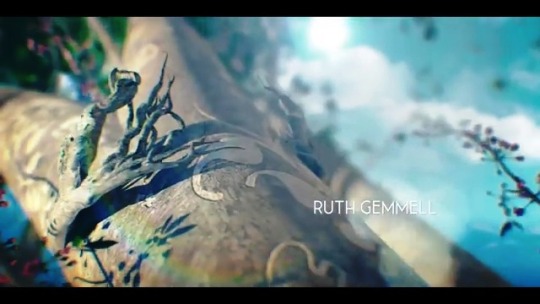


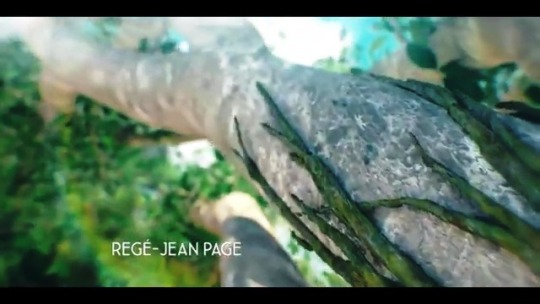


Bridgerton - Netflix - December 25, 2020 - Present
Period Drama / Romance (16 episodes to date)
Running Time: 57 - 72 minutes
Stars:
Adjoa Andoh as Lady Danbury
Lorraine Ashbourne as Mrs. Varley
Jonathan Bailey as Anthony, Viscount Bridgerton
Ruby Barker as Marina Thompson
Sabrina Bartlett as Siena Rosso
Harriet Cains as Philippa Featherington, the middle Featherington daughter
Bessie Carter as Prudence Featherington, the eldest Featherington daughter
Nicola Coughlan as Penelope Featherington
Phoebe Dynevor as Daphne Bassett (née Bridgerton), Duchess of Hastings
Ruth Gemmell as Violet, Dowager Viscountess Bridgerton
Florence Hunt as Hyacinth Bridgerton
Claudia Jessie as Eloise Bridgerton
Ben Miller as Archibald, Baron Featherington
Luke Newton as Colin Bridgerton.
Regé-Jean Page as Simon Bassett, Duke of Hastings.
Golda Rosheuvel as Queen Charlotte
Luke Thompson as Benedict Bridgerton
Will Tilston as Gregory Bridgerton
Polly Walker as Portia, Baroness Featherington
Julie Andrews as the voice of Lady Whistledown
Recurring
Ruby Stokes as Francesca Bridgerton
Molly McGlynn as Rose Nolan
Joanna Bobin as Lady Cowper
Jessica Madsen as the debutante Cressida Cowper
Jason Barnett as Jeffries
Hugh Sachs as Brimsley
Martins Imhangbe as Will Mondrich
Geraldine Alexander as Mrs. Wilson
Kathryn Drysdale as Genevieve Delacroix
Simon Ludders as Humboldt
Julian Ovenden as Sir Henry Granville
#Bridgerton#TV#Netflix#Period Drama#Romance#2000's#Andjoa Andoh#Lorraine Ashbourne#Jonathan Bailey#Ruby Barker#Sabrina Bartlett#Harriet Cains#Bessie Carter#Nicola Coughlan#Phoebe Dynevor#Ruth Gemmell#Florence Hunt#Claudia Jessie#Ben Miller#Luke Newton#Rege-Jean Page#Golda Rosheuvel#Luke Thompson#Will Tilston#Polly Walker#Julie Andrews
3 notes
·
View notes
Text
Group Clovis Final
In a very Parisian way to finish the 2022 Art History May Term, our final exam involved navigating the streets of Paris in groups of three students. After being handed the sites to visit, our group formed a route based on arrondissements and distance between each site. Starting at Jardin des Tuileries, we first hopped on the nearest metro and landed in the 5th arrondissement, where we found our first point of interest. “L’arbre des Rues” was a diamond in the rough, as the unassuming wall made the poem and the massive mural easy to miss (especially for our group at first). Though the poem was in French, the mural depicting a tree gave us insight into the overall message. After finding digital works of artist Pierre Alachinsky through the Centre Pompidou, we discovered that he seems to show a vested interest in mixing nature and civilization through his work. Though Alachinsky was well known for his Painting inspired by Central Park, seeing the mural reminded us of just how unique Paris is in terms of widespread urban parks and natural areas.

Our second stop took the group to our namesake, Rue Clovis. Perpendicular to the mural, Rue Clovis is in the heart of the 5ème arrondissement. The group immediately observed the status of the area as a student district, as institutions such as the Sorbonne and the City University of Paris seemed to own many of the buildings in the area.

Our third point of interest in the nearby 6ème arrondissement was within walking distance, taking the group by Luxembourg Gardens and various upscale restaurants and shops. Saint Sulpice church was a puzzling sight from the outside, as the construction nearly led us to believe it was closed; however, the Delacroix murals inside challenged us to realize the church’s significance in Paris, despite its relatively unknown origins. The murals Jacob Wrestling with the Angel and Heliodorus Driven from the Temple were directly across from each other on walls. Considering that the murals were painted by an incredibly well known artist, it was surprising that they were relatively tucked away and hidden from the entrance. The murals were incredibly significant in terms of Eugene Delacroix’s artistic legacy, as the National Delacroix Museum noted that the murals were one of his last works.
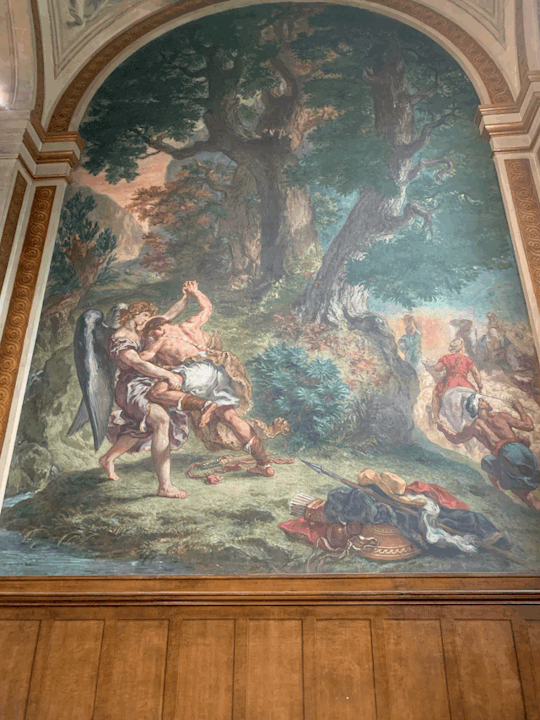

The next point of interest was Église Saint Germain des Près, and it was also walking distance as it is in the 6ème as well. This church seemed to be much more well known than the Saint Sulpice, and it was a familiar name after frequenting the metro in these past few weeks. Seeing the church on the outside raised questions about the age, as we had no clue considering the architectural detail. After reading that it was built in 543 AD (making it the oldest church in Paris), there was a sense of collective shock that the church withstood over a thousand years of wars and development.

Our next location, Pont Alexandre III, is probably one of the most visually dramatic bridges. At each end there are two bright golden statues of Alexander III, the man who laid the foundation stone for the bridge. It serves as a guide to Les Invalides, now an Army Museum and the final resting place for Napoleon. The bridge was built in 1900 and shows off France’s power and wealth.

Once the place of execution by guillotine during the French Revolution, our next stop, the Place de la Concorde, is now a busy roundabout with an obelisk in the center. There are eight statues that surround this obelisk, each representing a different city in France. We visited the Brest statue, which was a woman holding an object that seemed to look like a harp of some sort.
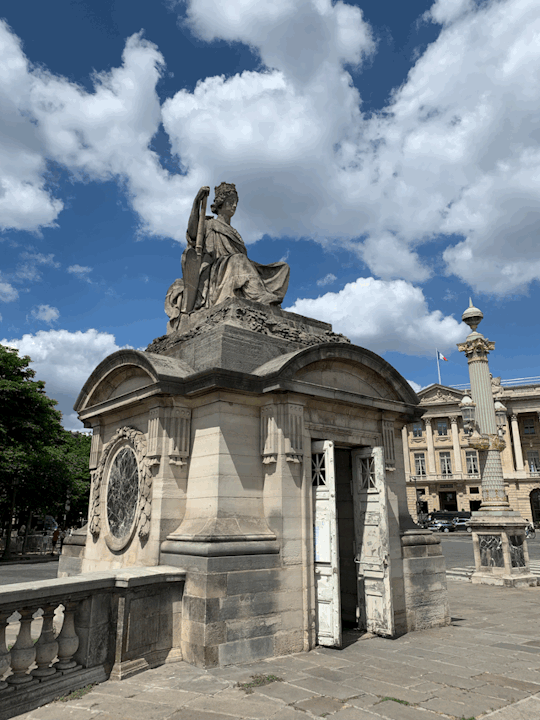
Our next stop was Musee de l’Homme, which translates pretty directly to the museum of mankind, an anthropology museum in the 16th district. The first thing we noticed when we got out of our metro station was the cool view of the Eiffel Tower just to the left of the building. The museum looked relatively small in comparison to some of the massive ones we have visited thus far, but we all agreed that the content looked quite interesting and something to check out either before we leave or the next time we are back.
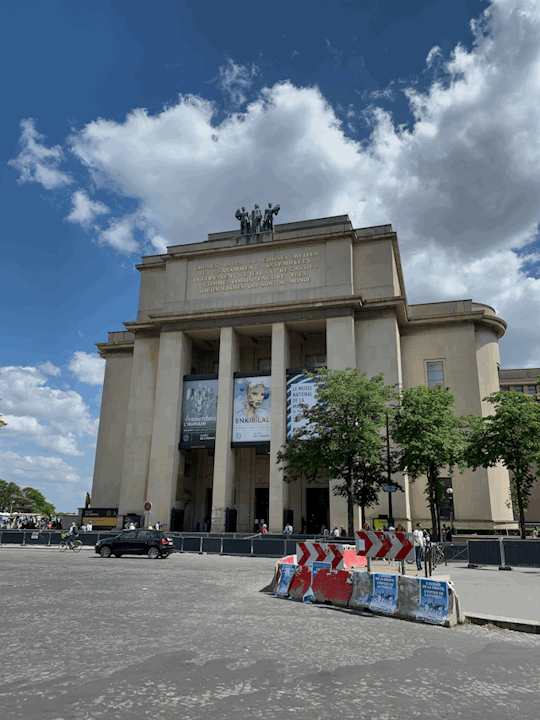
After this, we took a pretty hefty metro ride to get to the Pont tournament de la Grange aux Belles, also known as the turning bridge. We weren’t all too certain of what to expect, especially given that most of the bridges we have walked along thus far have been large and ornate, some containing locks all over the sides. When we arrived, we were pleasantly surprised at how small and unassuming the bridge was. We found it to be a lot more personal than some of the other bridges we have walked on the trip. It also had a pretty cool view of the neighborhood it was surrounded by, which we agreed is an aspect of Paris we have really enjoyed.

It was no easy trek to get to our next stop, the Temple of the Sibyl. The park surrounding this temple is large and beautiful, but also very hilly, and the temple was at the very top; we definitely got a good workout. Unfortunately, due to erosion and safety issues, the temple was closed off, but we were still able to see the lovely view of the trees in the area and the city in the distance. The temple was designed based off of a Roman temple. The Sibyl was a figure in Greek and Roman mythology (usually female) who told prophecies. Although this was a bit of a hike to get to, the views were amazing and it was an excellent spot to finish off our final expedition!
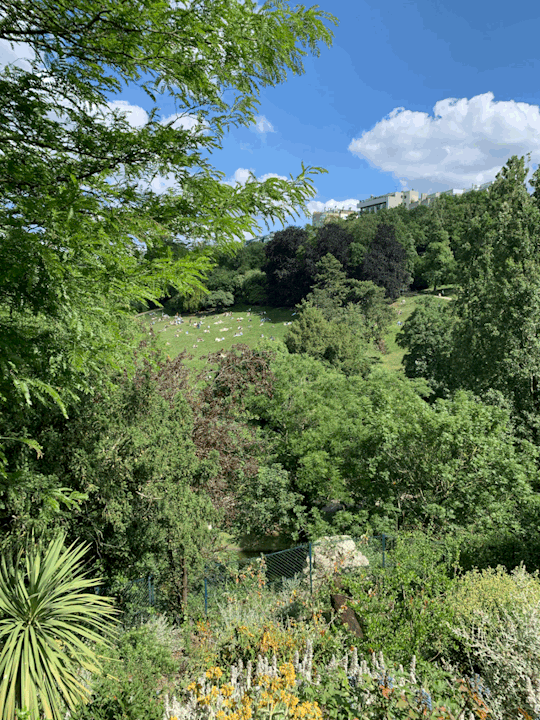
Sources:
https://www.hotel-de-la-marine.paris/en/The-Hotel-de-la-Marine/Place-de-la-Concorde/history-place-concorde
Michelin Green Guide Paris
2 notes
·
View notes
Text
Beatport Picks 5 Lossless Music March 2024 aif

DATE CREATED: 2024-03-25
Tracklist :
Ahmet Kilic, 2na - Yeke Yeke
BOBTECH, 808Hz (IR) - Codeine
Brannco & ANDREOS - Let You Go
Conde & Ayah Tlhanyane - Kuwala (Extended)
Coss Bocanegra - Gomorra
Dayvie - En La Cama (Original Mix)
Dj Revilla - Flautin
Doug English & Rrotik - Hood Life '24
Eduardo Romero - Pachanguear
Fred Everything, James Alexander Bright - Breathe
French 79 - FOIX
Gogan - Over The Moon
Gustaff, Hector Díez - Crash Baby
HNQO - Priority
James Curd - Walk with Me
Jarl Flamar - Scorpiones
Joris Delacroix & Silly Boy Blue - Fall In
Jose Alves - Guarandinga
Kora (CA) & Madota - Feel
Kostik Makso, Tibetania - Maitu
Lautaro Gabioud - Never Alone
Matt D, Claudio Deeper, Tasha LaRae - No Time To Waste
MI.LA,
Read the full article
0 notes
Text
Beatport Picks 5 Lossless Music March 2024 aif

DATE CREATED: 2024-03-25
Tracklist :
Ahmet Kilic, 2na - Yeke Yeke
BOBTECH, 808Hz (IR) - Codeine
Brannco & ANDREOS - Let You Go
Conde & Ayah Tlhanyane - Kuwala (Extended)
Coss Bocanegra - Gomorra
Dayvie - En La Cama (Original Mix)
Dj Revilla - Flautin
Doug English & Rrotik - Hood Life '24
Eduardo Romero - Pachanguear
Fred Everything, James Alexander Bright - Breathe
French 79 - FOIX
Gogan - Over The Moon
Gustaff, Hector Díez - Crash Baby
HNQO - Priority
James Curd - Walk with Me
Jarl Flamar - Scorpiones
Joris Delacroix & Silly Boy Blue - Fall In
Jose Alves - Guarandinga
Kora (CA) & Madota - Feel
Kostik Makso, Tibetania - Maitu
Lautaro Gabioud - Never Alone
Matt D, Claudio Deeper, Tasha LaRae - No Time To Waste
MI.LA,
Read the full article
0 notes
Text
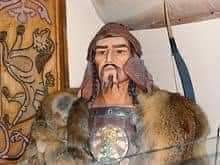
#卍TENGRÎkutUluğBaşBuğAttilahun
5th-century ruler of the Hunnic Empire
"#Atilla" and "Attila the #Hun" redirect here. For other uses, see Attila (disambiguation), Atilla (disambiguation), and Attila the Hun (disambiguation).
#Attila (/əˈtɪlə/, /ˈætələ/;fl. c. 406–453), frequently called Attila the Hun, was the ruler of the Huns from 434 until his death in March 453. He was also the leader of a tribal empire consisting of Huns, Ostrogoths, Alans and Bulgars, among others, in Central and Eastern Europe.
Quick Facts King and chieftain of the Hunnic Empire, Reign ...
During his reign, he was one of the most feared enemies of the Western and Eastern Roman Empires. He crossed the Danubetwice and plundered the Balkans, but was unable to take Constantinople. His unsuccessful campaign in Persia was followed in 441 by an invasion of the Eastern Roman (Byzantine) Empire, the success of which emboldened Attila to invade the West. He also attempted to conquer Roman Gaul (modern France), crossing the Rhine in 451 and marching as far as Aurelianum (Orléans) before being stopped in the Battle of the Catalaunian Plains.
He subsequently invaded Italy, devastating the northern provinces, but was unable to take Rome. He planned for further campaigns against the Romans, but died in 453. After Attila's death, his close adviser, Ardaricof the Gepids, led a Germanic revolt against Hunnic rule, after which the Hunnic Empire quickly collapsed. Attila would live on as a character in Germanic heroic legend.
Appearance and character
BildMór Than's 19th century painting of The Feast of Attila, based on a fragment of Priscus
There is no surviving first-hand account of Attila's appearance, but there is a possible second-hand source provided by Jordanes, who cites a description given by Priscus.
He was a man born into the world to shake the nations, the scourge of all lands, who in some way terrified all mankind by the dreadful rumors noised abroad concerning him. He was haughty in his walk, rolling his eyes hither and thither, so that the power of his proud spirit appeared in the movement of his body. He was indeed a lover of war, yet restrained in action, mighty in counsel, gracious to suppliants and lenient to those who were once received into his protection. Short of stature, with a broad chest and a large head; his eyes were small, his beard thin and sprinkled with grey; and he had a flat nose and swarthy skin, showing evidence of his origin.:182–183
Some scholars have suggested that this description is typically East Asian, because it has all the combined features that fit the physical type of people from Eastern Asia, and Attila's ancestors may have come from there.:202 Other historians also believed that the same descriptions were also evident on some Scythian people.
Etymology
BildA painting of Attila riding a pale horse, by French Romantic artist Eugène Delacroix (1798–1863)
Many scholars have argued that the name Attila derives from East Germanic origin; Attila is formed from the Gothic or Gepidic noun atta, "father", by means of the diminutive suffix -ila, meaning "little father", compare Wulfilafrom wulfs "wolf" and -ila, i.e. "little wolf".:386:29:46The Gothic etymology was first proposed by Jacob and Wilhelm Grimm in the early 19th century.:211 Maenchen-Helfen notes that this derivation of the name "offers neither phonetic nor semantic difficulties",:386 and Gerhard Doerfer notes that the name is simply correct Gothic.:29 Alexander Savelyev and Choongwon Jeong (2020) similarly state that Attila's name "must have been Gothic in origin." The name has sometimes been interpreted as a Germanization of a name of Hunnic origin.:29–32
Other scholars have argued for a Turkic origin of the name. Omeljan Pritsak considered Ἀττίλα (Attíla) a composite title-name which derived from Turkic *es (great, old), and *til (sea, ocean), and the suffix /a/.:444The stressed back syllabic tilassimilated the front member es, so it became *as.:444 It is a nominative, in form of attíl- (< *etsíl < *es tíl) with the meaning "the oceanic, universal ruler".:444 J. J. Mikkola connected it with Turkic āt (name, fame).:216 As another Turkic possibility, H. Althof (1902) considered it was related to Turkish atli (horseman, cavalier), or Turkish at (horse) and dil(tongue).:216 Maenchen-Helfen argues that Pritsak's derivation is "ingenious but for many reasons unacceptable",:387 while dismissing Mikkola's as "too farfetched to be taken seriously".:390 M. Snædal similarly notes that none of these proposals has achieved wide acceptance.:215–216Criticizing the proposals of finding Turkic or other etymologies for Attila, Doerfer notes that King George VI of the United Kingdom had a name of Greek origin, and Süleyman the Magnificent had a name of Arabic origin, yet that does not make them Greeks or Arabs: it is therefore plausible that Attila would have a name not of Hunnic origin.:31-32 Historian Hyun Jin Kim, however, has argued that the Turkic etymology is "more probable".:30
M. Snædal, in a paper that rejects the Germanic derivation but notes the problems with the existing proposed Turkic etymologies, argues that Attila's name could have originated from Turkic-Mongolian at, adyy/agta(gelding, warhorse) and Turkish atli (horseman, cavalier), meaning "possessor of geldings, provider of warhorses".:216–217
Historiography and source
BildFigure of Attila in a museum in Hungary
The historiography of Attila is faced with a major challenge, in that the only complete sources are written in Greek and Latin by the enemies of the Huns. Attila's contemporaries left many testimonials of his life, but only fragments of these remain.:25Priscus was a Byzantine diplomat and historian who wrote in Greek, and he was both a witness to and an actor in the story of Attila, as a member of the embassy of Theodosius II at the Hunnic court in 449. He was obviously biased by his political position, but his writing is a major source for information on the life of Attila, and he is the only person known to have recorded a physical description of him. He wrote a history of the late Roman Empire in eight books covering the period from 430 to 476.
Only fragments of Priscus' work remain. It was cited extensively by 6th-century historians Procopius and Jordanes,:413especially in Jordanes' The Origin and Deeds of the Goths, which contains numerous references to Priscus's history, and it is also an important source of information about the Hunnic empire and its neighbors. He describes the legacy of Attila and the Hunnic people for a century after Attila's death. Marcellinus Comes, a chancellor of Justinianduring the same era, also describes the relations between the Huns and the Eastern Roman Empire.:30
Numerous ecclesiastical writings contain useful but scattered information, sometimes difficult to authenticate or distorted by years of hand-copying between the 6th and 17th centuries. The Hungarian writers of the 12th century wished to portray the Huns in a positive light as their glorious ancestors, and so repressed certain historical elements and added their own legends.:32
The literature and knowledge of the Huns themselves was transmitted orally, by means of epics and chanted poems that were handed down from generation to generation.:354Indirectly, fragments of this oral history have reached us via the literature of the Scandinavians and Germans, neighbors of the Huns who wrote between the 9th and 13th centuries. Attila is a major character in many Medieval epics, such as the Nibelungenlied, as well as various Eddas and sagas.:32:354
Archaeological investigation has uncovered some details about the lifestyle, art, and warfare of the Huns. There are a few traces of battles and sieges, but the tomb of Attila and the location of his capital have not yet been found.:33–37
Early life and background
Main article: Huns
BildHuns in battle with the Alans. An 1870s engraving after a drawing by Johann Nepomuk Geiger (1805–1880 ).
The Huns were a group of Eurasian nomads, appearing from east of the Volga, who migrated further into Western Europec. 370 and built up an enormous empire there. Their main military techniques were mounted archery and javelinthrowing. They were in the process of developing settlements before their arrival in Western Europe, yet the Huns were a society of pastoral warriors:259 whose primary form of nourishment was meat and milk, products of their herds.
The origin and language of the Huns has been the subject of debate for centuries. According to some theories, their leaders at least may have spoken a Turkic language, perhaps closest to the modern Chuvash language.:444 One scholar suggests a relationship to Yeniseian.According to the Encyclopedia of European Peoples, "the Huns, especially those who migrated to the west, may have been a combination of central Asian Turkic, Mongolic, and Ugricstocks".
Attila's father Mundzuk was the brother of kings Octar and Ruga, who reigned jointly over the Hunnic empire in the early fifth century. This form of diarchy was recurrent with the Huns, but historians are unsure whether it was institutionalized, merely customary, or an occasional occurrence.:80 His family was from a noble lineage, but it is uncertain whether they constituted a royal dynasty. Attila's birthdate is debated; journalist Éric Deschodt and writer Herman Schreiber have proposed a date of 395.However, historian Iaroslav Lebedynsky and archaeologist Katalin Escher prefer an estimate between the 390s and the first decade of the fifth century.:40Several historians have proposed 406 as the date.:92:202
Attila grew up in a rapidly changing world. His people were nomads who had only recently arrived in Europe. They crossed the Volga river during the 370s and annexed the territory of the Alans, then attacked the Gothic kingdom between the Carpathian mountains and the Danube. They were a very mobile people, whose mounted archers had acquired a reputation for invincibility, and the Germanic tribes seemed unable to withstand them.:133–151 Vast populations fleeing the Huns moved from Germania into the Roman Empire in the west and south, and along the banks of the Rhine and Danube. In 376, the Goths crossed the Danube, initially submitting to the Romans but soon rebelling against Emperor Valens, whom they killed in the Battle of Adrianople in 378.:100 Large numbers of Vandals, Alans, Suebi, and Burgundians crossed the Rhineand invaded Roman Gaul on December 31, 406 to escape the Huns.:233 The Roman Empire had been split in half since 395 and was ruled by two distinct governments, one based in Ravenna in the West, and the other in Constantinople in the East. The Roman Emperors, both East and West, were generally from the Theodosian family in Attila's lifetime (despite several power struggles).:13
The Huns dominated a vast territory with nebulous borders determined by the will of a constellation of ethnically varied peoples. Some were assimilated to Hunnic nationality, whereas many retained their own identities and rulers but acknowledged the suzerainty of the king of the Huns.:11 The Huns were also the indirect source of many of the Romans' problems, driving various Germanic tribes into Roman territory, yet relations between the two empires were cordial: the Romans used the Huns as mercenaries against the Germans and even in their civil wars. Thus, the usurper Joanneswas able to recruit thousands of Huns for his army against Valentinian III in 424. It was Aëtius, later Patrician of the West, who managed this operation. They exchanged ambassadors and hostages, the alliance lasting from 401 to 450 and permitting the Romans numerous military victories.:111 The Huns considered the Romans to be paying them tribute, whereas the Romans preferred to view this as payment for services rendered. The Huns had become a great power by the time that Attila came of age during the reign of his uncle Ruga, to the point that Nestorius, the Patriarch of Constantinople, deplored the situation with these words: "They have become both masters and slaves of the Romans".:128
Campaigns against the Eastern Roman Empire
BildThe Empire of the Huns and subject tribes at the time of Attila
The death of Rugila (also known as Rua or Ruga) in 434 left the sons of his brother Mundzuk, Attila and Bleda, in control of the united Hun tribes. At the time of the two brothers' accession, the Hun tribes were bargaining with Eastern Roman Emperor Theodosius II's envoys for the return of several renegades who had taken refuge within the Eastern Roman Empire, possibly Hunnic nobles who disagreed with the brothers' assumption of leadership.
The following year, Attila and Bleda met with the imperial legation at Margus (Požarevac), all seated on horseback in the Hunnic manner, and negotiated an advantageous treaty. The Romans agreed to return the fugitives, to double their previous tribute of 350 Roman pounds (c. 115 kg) of gold, to open their markets to Hunnish traders, and to pay a ransom of eight solidi for each Roman taken prisoner by the Huns. The Huns, satisfied with the treaty, decamped from the Roman Empire and returned to their home in the Great Hungarian Plain, perhaps to consolidate and strengthen their empire. Theodosius used this opportunity to strengthen the walls of Constantinople, building the city's first sea wall, and to build up his border defenses along the Danube.
The Huns remained out of Roman sight for the next few years while they invaded the Sassanid Empire. They were defeated in Armenia by the Sassanids, abandoned their invasion, and turned their attentions back to Europe. In 440, they reappeared in force on the borders of the Roman Empire, attacking the merchants at the market on the north bank of the Danube that had been established by the treaty of 435.
Crossing the Danube, they laid waste to the cities of Illyricumand forts on the river, including (according to Priscus) Viminacium, a city of Moesia. Their advance began at Margus, where they demanded that the Romans turn over a bishop who had retained property that Attila regarded as his. While the Romans discussed the bishop's fate, he slipped away secretly to the Huns and betrayed the city to them.
While the Huns attacked city-states along the Danube, the Vandals (led by Geiseric) captured the Western Roman province of Africa and its capital of Carthage. Carthage was the richest province of the Western Empire and a main source of food for Rome. The Sassanid ShahYazdegerd II invaded Armenia in 441.[citation needed]
The Romans stripped the Balkan area of forces, sending them to Sicily in order to mount an expedition against the Vandals in Africa. This left Attila and Bleda a clear path through Illyricum into the Balkans, which they invaded in 441. The Hunnish army sacked Margus and Viminacium, and then took Singidunum (Belgrade) and Sirmium. During 442, Theodosius recalled his troops from Sicily and ordered a large issue of new coins to finance operations against the Huns. He believed that he could defeat the Huns and refused the Hunnish kings' demands.
Attila responded with a campaign in 443. For the first time (as far as the Romans knew) his forces were equipped with battering rams and rolling siege towers, with which they successfully assaulted the military centers of Ratiara and Naissus (Niš) and massacred the inhabitants. Priscus said "When we arrived at Naissus we found the city deserted, as though it had been sacked; only a few sick persons lay in the churches. We halted at a short distance from the river, in an open space, for all the ground adjacent to the bank was full of the bones of men slain in war."
Advancing along the Nišava River, the Huns next took Serdica (Sofia), Philippopolis (Plovdiv), and Arcadiopolis (Lüleburgaz). They encountered and destroyed a Roman army outside Constantinople but were stopped by the double walls of the Eastern capital. They defeated a second army near Callipolis (Gelibolu).
Theodosius, unable to make effective armed resistance, admitted defeat, sending the Magister militum per OrientemAnatolius to negotiate peace terms. The terms were harsher than the previous treaty: the Emperor agreed to hand over 6,000 Roman pounds (c. 2000 kg) of gold as punishment for having disobeyed the terms of the treaty during the invasion; the yearly tribute was tripled, rising to 2,100 Roman pounds (c. 700 kg) in gold; and the ransom for each Roman prisoner rose to 12 solidi.
Their demands were met for a time, and the Hun kings withdrew into the interior of their empire. Bleda died following the Huns' withdrawal from Byzantium (probably around 445). Attila then took the throne for himself, becoming the sole ruler of the Huns.
Solitary kingship
In 447, Attila again rode south into the Eastern Roman Empirethrough Moesia. The Roman army, under Gothic magister militum Arnegisclus, met him in the Battle of the Utus and was defeated, though not without inflicting heavy losses. The Huns were left unopposed and rampaged through the Balkans as far as Thermopylae.
Constantinople itself was saved by the Isaurian troops of magister militum per Orientem Zeno and protected by the intervention of prefect Constantinus, who organized the reconstruction of the walls that had been previously damaged by earthquakes and, in some places, to construct a new line of fortification in front of the old. Callinicus, in his Life of Saint Hypatius, wrote:
The barbarian nation of the Huns, which was in Thrace, became so great that more than a hundred cities were captured and Constantinople almost came into danger and most men fled from it. ... And there were so many murders and blood-lettings that the dead could not be numbered. Ay, for they took captive the churches and monasteries and slew the monks and maidens in great numbers.
In the west
BildThe general path of the Hun forces in the invasion of Gaul
In 450, Attila proclaimed his intent to attack the Visigothkingdom of Toulouse by making an alliance with Emperor Valentinian III. He had previously been on good terms with the Western Roman Empire and its influential general Flavius Aëtius. Aëtius had spent a brief exileamong the Huns in 433, and the troops that Attila provided against the Goths and Bagaudaehad helped earn him the largely honorary title of magister militumin the west. The gifts and diplomatic efforts of Geiseric, who opposed and feared the Visigoths, may also have influenced Attila's plans.
However, Valentinian's sister was Honoria, who had sent the Hunnish king a plea for help—and her engagement ring—in order to escape her forced betrothal to a Roman senator in the spring of 450. Honoria may not have intended a proposal of marriage, but Attila chose to interpret her message as such. He accepted, asking for half of the western Empire as dowry.
When Valentinian discovered the plan, only the influence of his mother Galla Placidia convinced him to exile Honoria, rather than killing her. He also wrote to Attila, strenuously denying the legitimacy of the supposed marriage proposal. Attila sent an emissary to Ravenna to proclaim that Honoria was innocent, that the proposal had been legitimate, and that he would come to claim what was rightfully his.
Attila interfered in a succession struggle after the death of a Frankish ruler. Attila supported the elder son, while Aëtius supported the younger. (The location and identity of these kings is not known and subject to conjecture.) Attila gathered his vassals—Gepids, Ostrogoths, Rugians, Scirians, Heruls, Thuringians, Alans, Burgundians, among others–and began his march west. In 451, he arrived in Belgica with an army exaggerated by Jordanes to half a million strong.
On April 7, he captured Metz. Other cities attacked can be determined by the hagiographicvitae written to commemorate their bishops: Nicasius was slaughtered before the altar of his church in Rheims; Servatus is alleged to have saved Tongerenwith his prayers, as Saint Genevieve is said to have saved Paris. Lupus, bishop of Troyes, is also credited with saving his city by meeting Attila in person.
Aëtius moved to oppose Attila, gathering troops from among the Franks, the Burgundians, and the Celts. A mission by Avitus and Attila's continued westward advance convinced the Visigoth king Theodoric I (Theodorid) to ally with the Romans. The combined armies reached Orléans ahead of Attila, thus checking and turning back the Hunnish advance. Aëtius gave chase and caught the Huns at a place usually assumed to be near Catalaunum (modern Châlons-en-Champagne). Attila decided to fight the Romans on plains where he could use his cavalry.
The two armies clashed in the Battle of the Catalaunian Plains, the outcome of which is commonly considered to be a strategic victory for the Visigothic-Roman alliance. Theodoric was killed in the fighting, and Aëtius failed to press his advantage, according to Edward Gibbon and Edward Creasy, because he feared the consequences of an overwhelming Visigothic triumph as much as he did a defeat. From Aëtius' point of view, the best outcome was what occurred: Theodoric died, Attila was in retreat and disarray, and the Romans had the benefit of appearing victorious.
Invasion of Italy and death
BildRaphael's The Meeting between Leo the Great and Attila depicts Leo, escorted by Saint Peter and Saint Paul, meeting with the Hun emperor outside Rome.
Attila returned in 452 to renew his marriage claim with Honoria, invading and ravaging Italy along the way. Communities became established in what would later become Venice as a result of these attacks when the residents fled to small islands in the Venetian Lagoon. His army sacked numerous cities and razed Aquileia so completely that it was afterwards hard to recognize its original site.:159Aëtius lacked the strength to offer battle, but managed to harass and slow Attila's advance with only a shadow force. Attila finally halted at the River Po. By this point, disease and starvation may have taken hold in Attila's camp, thus hindering his war efforts and potentially contributing to the cessation of invasion.[citation needed]
Emperor Valentinian III sent three envoys, the high civilian officers Gennadius Avienus and Trigetius, as well as the Bishop of Rome Leo I, who met Attila at Mincio in the vicinity of Mantua and obtained from him the promise that he would withdraw from Italy and negotiate peace with the Emperor. Prosper of Aquitainegives a short description of the historic meeting, but gives all the credit to Leo for the successful negotiation. Priscus reports that superstitious fear of the fate of Alaric gave him pause—as Alaric died shortly after sacking Rome in 410.
Italy had suffered from a terrible famine in 451 and her crops were faring little better in 452. Attila's devastating invasion of the plains of northern Italy this year did not improve the harvest.:161 To advance on Rome would have required supplies which were not available in Italy, and taking the city would not have improved Attila's supply situation. Therefore, it was more profitable for Attila to conclude peace and retreat to his homeland.:160–161
Furthermore, an East Roman force had crossed the Danube under the command of another officer also named Aetius—who had participated in the Council of Chalcedon the previous year—and proceeded to defeat the Huns who had been left behind by Attila to safeguard their home territories. Attila, hence, faced heavy human and natural pressures to retire "from Italy without ever setting foot south of the Po".:163 As Hydatiuswrites in his Chronica Minora:
The Huns, who had been plundering Italy and who had also stormed a number of cities, were victims of divine punishment, being visited with heaven-sent disasters: famine and some kind of disease. In addition, they were slaughtered by auxiliaries sent by the Emperor Marcianand led by Aetius, and at the same time, they were crushed in their [home] settlements ... Thus crushed, they made peace with the Romans and all returned to their homes.
Death
BildThe Huns, led by Attila, invade Italy (Attila, the Scourge of God, by Ulpiano Checa, 1887)
Marcian was the successor of Theodosius, and he had ceased paying tribute to the Huns in late 450 while Attila was occupied in the west. Multiple invasions by the Huns and others had left the Balkans with little to plunder.[citation needed]
After Attila left Italy and returned to his palace across the Danube, he planned to strike at Constantinople again and reclaim the tribute which Marcian had stopped. However, he died in the early months of 453.
The conventional account from Priscus says that Attila was at a feast celebrating his latest marriage, this time to the beautiful young Ildico (the name suggests Gothic or Ostrogothorigins).:164 In the midst of the revels, however, he suffered severe bleeding and died. He may have had a nosebleed and choked to death in a stupor. Or he may have succumbed to internal bleeding, possibly due to ruptured esophageal varices. Esophageal varices are dilated veins that form in the lower part of the esophagus, often caused by years of excessive alcohol consumption; they are fragile and can easily rupture, leading to death by hemorrhage.
Another account of his death was first recorded 80 years after the events by Roman chronicler Marcellinus Comes. It reports that "Attila, King of the Huns and ravager of the provinces of Europe, was pierced by the hand and blade of his wife". One modern analyst suggests that he was assassinated, but most reject these accounts as no more than hearsay, preferring instead the account given by Attila's contemporary Priscus, recounted in the 6th century by Jordanes:
On the following day, when a great part of the morning was spent, the royal attendants suspected some ill and, after a great uproar, broke in the doors. There they found the death of Attila accomplished by an effusion of blood, without any wound, and the girl with downcast face weeping beneath her veil. Then, as is the custom of that race, they plucked out the hair of their heads and made their faces hideous with deep wounds, that the renowned warrior might be mourned, not by effeminate wailings and tears, but by the blood of men. Moreover a wondrous thing took place in connection with Attila's death. For in a dream some god stood at the side of Marcian, Emperor of the East, while he was disquieted about his fierce foe, and showed him the bow of Attila broken in that same night, as if to intimate that the race of Huns owed much to that weapon. This account the historian Priscus says he accepts upon truthful evidence. For so terrible was Attila thought to be to great empires that the gods announced his death to rulers as a special boon.
His body was placed in the midst of a plain and lay in state in a silken tent as a sight for men's admiration. The best horsemen of the entire tribe of the Huns rode around in circles, after the manner of circus games, in the place to which he had been brought and told of his deeds in a funeral dirge in the following manner: "The chief of the Huns, King Attila, born of his sire Mundiuch, lord of bravest tribes, sole possessor of the Scythian and German realms—powers unknown before—captured cities and terrified both empires of the Roman world and, appeased by their prayers, took annual tribute to save the rest from plunder. And when he had accomplished all this by the favor of fortune, he fell, not by wound of the foe, nor by treachery of friends, but in the midst of his nation at peace, happy in his joy and without sense of pain. Who can rate this as death, when none believes it calls for vengeance?"
When they had mourned him with such lamentations, a strava, as they call it, was celebrated over his tomb with great reveling. They gave way in turn to the extremes of feeling and displayed funereal grief alternating with joy. Then in the secrecy of night they buried his body in the earth. They bound his coffins, the first with gold, the second with silver and the third with the strength of iron, showing by such means that these three things suited the mightiest of kings; iron because he subdued the nations, gold and silver because he received the honors of both empires. They also added the arms of foemen won in the fight, trappings of rare worth, sparkling with various gems, and ornaments of all sorts whereby princely state is maintained. And that so great riches might be kept from human curiosity, they slew those appointed to the work—a dreadful pay for their labor; and thus sudden death was the lot of those who buried him as well as of him who was buried.:254–259
Attila's sons Ellac, Dengizich and Ernak, "in their rash eagerness to rule they all alike destroyed his empire".:259 They "were clamoring that the nations should be divided among them equally and that warlike kings with their peoples should be apportioned to them by lot like a family estate".:259 Against the treatment as "slaves of the basest condition" a Germanic alliance led by the Gepid ruler Ardaric (who was noted for great loyalty to Attila:199) revolted and fought with the Huns in Pannonia in the Battle of Nedao 454 AD.:260–262 Attila's eldest son Ellac was killed in that battle.:262 Attila's sons "regarding the Goths as deserters from their rule, came against them as though they were seeking fugitive slaves", attacked Ostrogothic co-ruler Valamir(who also fought alongside Ardaric and Attila at the Catalaunian Plains:199), but were repelled, and some group of Huns moved to Scythia (probably those of Ernak).:268–269 His brother Dengizich attempted a renewed invasion across the Danube in 468 AD, but was defeated at the Battle of Bassianae by the Ostrogoths.:272–273 Dengizich was killed by Roman-Gothic general Anagast the following year, after which the Hunnic dominion ended.:168
Attila's many children and relatives are known by name and some even by deeds, but soon valid genealogical sources all but dried up, and there seems to be no verifiable way to trace Attila's descendants. This has not stopped many genealogists from attempting to reconstruct a valid line of descent for various medieval rulers. One of the most credible claims has been that of the Nominalia of the Bulgarian khans for mythological Avitoholand Irnik from the Dulo clan of the Bulgars.:103:59, 142
Later folklore and iconography
Further information: Attila in popular culture
BildIllustration of the meeting between Attila and Pope Leo from the Chronicon Pictum, c. 1360
Jordanes embellished the report of Priscus, reporting that Attila had possessed the "Holy War Sword of the Scythians", which was given to him by Mars and made him a "prince of the entire world".
By the end of the 12th century the royal court of Hungaryproclaimed their descent from Attila. Lampert of Hersfeld's contemporary chronicles report that shortly before the year 1071, the Sword of Attila had been presented to Otto of Nordheim by the exiled queen of Hungary, Anastasia of Kiev. This sword, a cavalry sabre now in the Kunsthistorisches Museum in Vienna, appears to be the work of Hungarian goldsmiths of the ninth or tenth century.
An anonymous chronicler of the medieval period represented the meeting of Pope Leo and Atilla as attended also by Saint Peter and Saint Paul, "a miraculous tale calculated to meet the taste of the time" This apotheosis was later portrayed artistically by the Renaissance artist Raphael and sculptor Algardi, whom eighteenth-century historian Edward Gibbon praised for establishing "one of the noblest legends of ecclesiastical tradition".
According to a version of this narrative related in the Chronicon Pictum, a mediaeval Hungarian chronicle, the Pope promised Attila that if he left Rome in peace, one of his successors would receive a holy crown (which has been understood as referring to the Holy Crown of Hungary).
Some histories and chronicles describe him as a great and noble king, and he plays major roles in three Norse sagas: Atlakviða,Volsunga saga, and Atlamál. The Polish Chroniclerepresents Attila's name as Aquila.
Frutolf of Michelsberg and Otto of Freising pointed out that some songs as "vulgar fables" made Theoderic the Great, Attila and Ermanaric contemporaries, when any reader of Jordanes knew that this was not the case. This refers to the so-called historical poems about Dietrich von Bern(Theoderic), in which Etzel (Attila) is Dietrich's refuge in exile from his wicked uncle Ermenrich (Ermanaric). Etzel is most prominent in the poems Dietrichs Flucht and the Rabenschlacht. Etzel also appears as Kriemhild's second noble husband in the Nibelungenlied, in which Kriemhild causes the destruction of both the Hunnish kingdom and that of her Burgundian relatives.
In 1812, Ludwig van Beethovenconceived the idea of writing an opera about Attila and approached August von Kotzebue to write the libretto. It was, however, never written.In 1846, Giuseppe Verdi wrote the opera, loosely based on episodes in Attila's invasion of Italy.
In World War I, Allied propaganda referred to Germans as the "Huns", based on a 1900 speech by Emperor Wilhelm II praising Attila the Hun's military prowess, according to Jawaharlal Nehru's Glimpses of World History.Der Spiegel commented on 6 November 1948, that the Sword of Attila was hanging menacingly over Austria.
American writer Cecelia Hollandwrote The Death of Attila (1973), a historical novel in which Attila appears as a powerful background figure whose life and death deeply affect the protagonists, a young Hunnic warrior and a Germanic one.
The name has many variants in several languages: Atli and Atle in Old Norse; Etzel in Middle High German (Nibelungenlied); Ætla in Old English; Attila, Atilla, and Etele in Hungarian (Attila is the most popular); Attila, Atilla, Atilay, or Atila in Turkish; and Adil and Edil in Kazakh or Adil ("same/similar") or Edil ("to use") in Mongolian.
In modern Hungary and in Turkey, "Attila" and its Turkish variation "Atilla" are commonly used as a male first name. In Hungary, several public places are named after Attila; for instance, in Budapest there are 10 Attila Streets, one of which is an important street behind the Buda Castle. When the Turkish Armed Forces invaded Cyprus in 1974, the operations were named after Attila ("The Attila Plan").
The 1954 Universal Internationalfilm Sign of the Pagan starred Jack Palance as Attila.
Depictions of Attila
Bild
Attila the Hun
Bild
Attila the Hun in an illustration in the Poetic Edda
Bild
A nineteenth-century depiction of Attila. Certosa di Pavia - Medallion at the base of the facade. The Latin inscription tells that this is Attila, the scourge of God.
Bild
Image of Attila
Bild
The Meeting of Leo I
and Attila
by Alessandro Algardi
(1646–1653 )
#FulinASTKHCLulinPiyi.🐺🌲🐉
0 notes